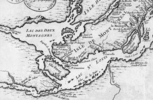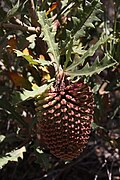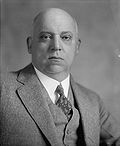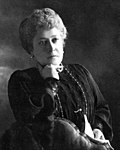Wikipedia:Today's featured article/May 2018
| << | Today's featured articles for May 2018 | >> | ||||
|---|---|---|---|---|---|---|
| Su | Mo | Tu | We | Th | Fr | Sa |
| 1 | 2 | 3 | 4 | 5 | ||
| 6 | 7 | 8 | 9 | 10 | 11 | 12 |
| 13 | 14 | 15 | 16 | 17 | 18 | 19 |
| 20 | 21 | 22 | 23 | 24 | 25 | 26 |
| 27 | 28 | 29 | 30 | 31 | ||
May 1
The Standing Liberty quarter was a 25-cent coin struck by the United States Mint from 1916 to 1930. It succeeded the Barber quarter, which had been minted since 1892. Featuring the goddess of Liberty on one side and an eagle in flight on the other, the coin was designed by sculptor Hermon Atkins MacNeil. In 1915, he submitted a design that showed Liberty on guard against attacks. The Mint required modifications, and his revised version included dolphins to represent the oceans. In late 1916, Mint officials made major changes, but MacNeil was allowed to create a new design, which included a chain mail vest covering Liberty's formerly bare breast. In circulation, the coin's date wore away quickly, and Mint engravers modified the design to address the issue in 1925. The Standing Liberty quarter was discontinued in 1931, a year in which no quarters were struck. The Washington quarter was introduced the next year to celebrate the bicentennial of George Washington's birth. (Full article...)
May 2
Naruto Uzumaki is the fictional protagonist of the Japanese manga series Naruto, created by Masashi Kishimoto. A carefree, optimistic and boisterous teen ninja who befriends other ninja, he aspires to become the leader of his fictional village, Konohagakure. He appears in anime, films, video games and original video animations, as well as a sequel Boruto: Naruto Next Generations, with his son Boruto Uzumaki as the protagonist. Kishimoto initially aimed to keep the character "simple and stupid", while giving him many attributes of an ideal hero, and a tragic past. The author has revised Naruto's image many times, providing the character with different clothes intended to appeal to Western audiences and to make him easier to illustrate. Naruto is voiced by Junko Takeuchi (pictured) in the original animated series and Maile Flanagan in the English adaptations. The character's development has been praised by anime and manga publications, and has drawn scholarly attention. (Full article...)
May 3
Hurricane Carmen was the most intense tropical cyclone of the 1974 Atlantic hurricane season. A destructive and widespread storm, Carmen originated as a tropical disturbance that traveled westward from Africa, spawning a tropical depression east of the Lesser Antilles on August 29. Moving through the Caribbean Sea, it quickly strengthened to a Category 4 hurricane on the Saffir–Simpson scale, and made landfall on the Yucatán Peninsula. It turned north into the Gulf of Mexico, re-intensified, and made a second landfall in the marshland of southern Louisiana, dissipating over eastern Texas on September 10. Tropical cyclone watches and warnings had been issued for the storm, and around 100,000 residents left their homes and sought shelter. Damage was lighter than first feared, but the sugar industry suffered substantial losses. The hurricane killed eight people and caused damage valued at $162 million. The name Carmen was retired from the list of Atlantic tropical cyclone names in 1975. (Full article...)
May 4
New York State Route 343 (NY 343) is a state highway in Dutchess County, in the Hudson Valley of the U.S. state of New York. It runs east–west from the intersection of NY 82 in the village of Millbrook to the Connecticut state line in the hamlet of Amenia, where Connecticut Route 343 continues briefly eastward. It was originally the Dover branch of the Dutchess Turnpike, a 19th-century transportation route between Litchfield County, Connecticut, and the city of Poughkeepsie. NY 343 was designated in 1930, connecting Amenia to the state line, but was relocated a few years later onto the portion of NY 200 from South Millbrook to the hamlet of Dover Plains. Landmarks along the way include the Silo Ridge Country Club in the hamlet of Wassaic, Beekman Park in Amenia, and the Troutbeck Conference Center in the hamlet of Leedsville. Connecticut Route 343 passes through more rural and residential areas into the town of Sharon, Connecticut, where it terminates at a junction with Route 4 and Route 41. (Full article...)
May 5
The CMLL World Middleweight Championship is a professional wrestling world championship of the Mexican wrestling promotion Consejo Mundial de Lucha Libre. While lighter weight classes are regularly ignored in wrestling promotions in the United States, more emphasis is placed on the lighter classes in Mexico. The middleweight division range in Mexico is between 82 kg (181 lb) and 87 kg (192 lb), but the weight limits are not strictly adhered to. As it is a professional wrestling championship, it is not won by actual competition, but by a scripted ending to a match or storyline. Dragón Rojo Jr., the longest reigning CMLL champion, was defeated on March 25, 2017, by Ángel de Oro, the current champion. Since its creation in 1991, the championship has been held by 12 wrestlers for a total of 17 individual reigns. El Dandy is the only three-time champion; he also has the shortest reign of any champion (his first reign) at 63 days. (Full article...)
Part of the Current Consejo Mundial de Lucha Libre championships featured topic.
May 6
Maniac Mansion is a 1987 graphic adventure video game developed and published by Lucasfilm Games. It follows teenage protagonist Dave Miller as he solves puzzles and attempts to rescue his girlfriend from a mad scientist. Initially released for the Commodore 64 and Apple II, Maniac Mansion was Lucasfilm Games' first self-published product. Conceived by Ron Gilbert and Gary Winnick, it tells a comedic story that draws on horror film and B-movie clichés. Gilbert developed Maniac Mansion's innovative point-and-click interface, which became a standard feature in the genre. To speed up production, he created a game engine called SCUMM, which was used in many later LucasArts titles. Maniac Mansion was critically acclaimed for its graphics, cutscenes, animation and humor. Writer Orson Scott Card praised it as a step toward "computer games [becoming] a valid storytelling art". The game's success solidified Lucasfilm as a serious rival to adventure game studios such as Sierra On-Line. (Full article...)
May 7
The Fountainhead is a 1943 novel by Russian-American author Ayn Rand. The protagonist, Howard Roark, is an individualistic young architect who designs modernist buildings and refuses to compromise with an architectural establishment unwilling to accept innovation. Roark embodies what Rand believed to be the ideal man, and his struggle reflects Rand's belief that individualism is superior to collectivism. Twelve publishers rejected the manuscript before an editor at the Bobbs-Merrill Company risked his job to get it published. Contemporary reviewers' opinions were mixed. Some praised the novel as a powerful paean to individualism, while others thought it overlong and lacking sympathetic characters. Initial sales were slow, but the book gained a following by word of mouth. It became a bestseller, and more than 6.5 million copies have been sold worldwide. The novel was Rand's first major literary success and has had a lasting influence, especially among architects and right-libertarians. (Full article...)
May 8
The Battle of the Cedars (May 1776) was a series of skirmishes early in the American Revolutionary War in and around the Cedars, 45 km (28 mi) west of Montreal, British North America. Continental Army units were opposed by a small number of British troops leading militia, together with indigenous forces (primarily Iroquois). Brigadier General Benedict Arnold, commanding the American military garrison at Montreal, had placed troops at the Cedars in April on rumors of British military preparations. The garrison surrendered to a force led by Captain George Forster, and reinforcements were captured the next day. All of the American captives were eventually released in a prisoner swap agreement, but the deal was repudiated by Congress, and no British prisoners were freed. News of the affair included greatly inflated reports of casualties, and often included graphic but false accounts of atrocities committed by the Iroquois, who made up the majority of the British forces. (Full article...)
Part of the Canadian campaign of 1775 featured topic.
May 9
Siward was an earl of 11th-century northern England. The Old Norse nickname Digri and its Latin translation Grossus ("the stout") are given to him by near-contemporary texts. Siward was probably of Scandinavian origin, perhaps a relative of Earl Ulf, and emerged as a powerful regional strongman in England during the reign of Cnut the Great (1016–1035). Cnut was a Scandinavian ruler who conquered England in the 1010s, and Siward was one of the many Scandinavians who came to England in the aftermath of that conquest. Siward rose to become a sub-ruler of most of northern England. In the early 1050s he turned against the Scottish ruler Mac Bethad mac Findlaích. Despite the death of his son Osbjorn, Siward defeated Mac Bethad in battle in 1054. More than half a millennium later the Scotland adventure earned him a place in William Shakespeare's Macbeth. St Olave's church in York and nearby Heslington Hill are associated with Siward. (Full article...)
May 10
Pobeda was the last of the three Peresvet-class pre-dreadnought battleships built for the Imperial Russian Navy at the end of the nineteenth century. Launched on 10 May 1900, the ship was assigned to the Pacific Squadron upon completion, and in 1903 was based at Port Arthur. During the Russo-Japanese War of 1904–1905, she participated in the battles of Port Arthur and the Yellow Sea. Having escaped serious damage in these engagements, Pobeda was sunk by gunfire during the Siege of Port Arthur, and then salvaged by the Japanese and placed into service under the name Suwo. Rearmed and re-boilered by the Japanese, Suwo was classified by the Imperial Japanese Navy as a coastal defense ship in 1908 and served as a training ship for several years. She was the flagship of the Japanese squadron at the Battle of Tsingtao at the beginning of World War I and continued in that role until she became a gunnery training ship in 1917. The ship was disarmed in 1922 to comply with the terms of the Washington Naval Treaty and probably scrapped around that time. (Full article...)
May 11
Richard Feynman (May 11, 1918 – February 15, 1988) was an American theoretical physicist who received the Nobel Prize in Physics in 1965 for his contributions to quantum electrodynamics, jointly with Julian Schwinger and Sin'ichirō Tomonaga. He developed the path integral formulation of quantum mechanics, and studied superfluidity in supercooled liquid helium. During World War II he assisted in the development of the atomic bomb, and in the 1980s he was a member of the Rogers Commission that investigated the Space Shuttle Challenger disaster. He was a pioneer in the field of quantum computing, and introduced the concept of nanotechnology. Through his lectures and books, including the semi-autobiographical Surely You're Joking, Mr. Feynman! and What Do You Care What Other People Think?, he was an avid popularizer of physics. In a 1999 poll of leading physicists, he was ranked as one of the ten greatest physicists of all time. (Full article...)
May 12
Heterodontosaurus was a dinosaur of the Early Jurassic, 200–190 million years ago. It was named in 1962 after a skull fossil was discovered in South Africa. The genus name means "different toothed lizard", in reference to its unusual heterodont dentition, including small, incisor-like teeth in the upper jaw, followed by long, canine-like tusks. Additional specimens have been found, including an almost complete skeleton in 1966. Though it was a small dinosaur, Heterodontosaurus was one of the largest members of its family, reaching between 1.18 m (3.9 ft)* and possibly 1.75 m (5.7 ft)* in length, and weighing between 2 and 10 kg (4.4 and 22.0 lb). The body was short with a long tail. The five-fingered forelimbs were long and relatively robust; the hind-limbs were long, slender, and had four toes. The skull was elongated, narrow, and triangular when viewed from the side. The front of the jaws were covered in a keratinous beak. (Full article...)
May 13
Banksia aculeata, the prickly banksia, is a plant of the family Proteaceae native to the Stirling Range in the southwest of Western Australia. A bushy shrub up to 2 m (7 ft) tall, it has fissured grey bark on its trunk and branches, and dense foliage and leaves with very prickly serrated margins. Its unusual pinkish, pendent (hanging) flower spikes, known as inflorescences, are generally hidden in the foliage and appear during the early summer. Unlike many other banksia species, it does not have a woody base, or lignotuber. Although it was collected in the 1840s by the naturalist James Drummond, it was not formally described until 1981, in Alex George's monograph of the genus. A rare plant, B. aculeata is found in gravelly soils in elevated areas. Native to a habitat burnt by periodic bushfires, it is killed by fire and regenerates from seed afterwards. In contrast to other Western Australian banksias, it appears to have some resistance to Phytophthora cinnamomi, a soil-borne water mould. (Full article...)
May 14
The school that became Texas A&M University, the first public institution of higher education in Texas, was founded in 1871 as the Agricultural and Mechanical College of Texas. Established under the Morrill Act of 1862, it was originally proposed as a branch of the yet-to-be-created University of Texas, but the Texas legislature never gave that university any authority over Texas A&M. For much of its first century, enrollment was restricted to white men who were willing to participate in the Corps of Cadets and receive military training. Shortly after World War II, the legislature redefined Texas A&M as a university and the flagship school of the Texas A&M University System, cementing the school's status as an institution separate from the University of Texas. In the 1960s, the state legislature renamed the school Texas A&M University, with the "A&M" becoming purely symbolic. Membership in the Corps of Cadets became voluntary, and the school became racially integrated and coeducational. (Full article...)
May 15
"No Rest for the Wicked" is the third-season finale of The CW television series Supernatural. Written by series creator Eric Kripke and directed by Kim Manners, the episode was first broadcast in the U.S. on May 15, 2008. The narrative follows Sam (Jared Padalecki) and Dean Winchester (Jensen Ackles), brothers who hunt supernatural creatures, as they attempt to save Dean's soul from damnation. The episode marks the final appearance of Katie Cassidy as the demon Ruby. The writers initially intended that Sam would save Dean, but the 2007–08 Writers Guild of America strike prevented the development of that storyline throughout the season. Dean is instead killed, and sent to Hell. The episode received high ratings for the season, and garnered generally positive reviews from critics. The decision to follow through with Dean's Hell-bound contract was praised, as were the performances of Padalecki and Ackles. Sierra McCormick was noted for her "creepy" demon character Lilith. (Full article...)
May 16
The Battle of Albuera (16 May 1811) was fought during the Peninsular War. A mixed British, Spanish and Portuguese corps engaged elements of the French Armée du Midi (Army of the South) at the small Spanish village of La Albuera, about 20 kilometres (12 mi) south of the frontier fortress town of Badajoz, Spain. Since October 1810, Marshal Masséna's French Army of Portugal had been tied down in an increasingly hopeless stand-off against Wellington's Allied forces. Acting on Napoleon's orders, in early 1811 Marshal Soult led a French expedition from Andalusia into Extremadura in a bid to draw Allied forces away from the battle lines and ease Masséna's plight. In April 1811, following news of Masséna's complete withdrawal from Portugal, Wellington sent the powerful Anglo-Portuguese Army commanded by Sir William Beresford to retake the border town. Meeting at Albuera, both sides suffered heavily, and the French finally withdrew on 18 May. (Full article...)
May 17
Ngô Đình Cẩn (1911–1964) was a younger brother and confidant of South Vietnam's first president, Ngô Đình Diệm, who put Cẩn in charge of central Vietnam, stretching from Phan Thiết in the south to the border at the 17th parallel. Based in the former imperial capital of Huế, Cẩn earned a reputation as the most oppressive of the Ngô brothers, operating private armies and secret police that controlled the central region. Cẩn's influence began to wane after his elder brother Ngô Đình Thục was appointed the Roman Catholic Archbishop of Huế. Thục overshadowed Cẩn and aggressively promoted Catholicism, which led to the banning of the Buddhist flag in 1963 during Vesak, the celebration of the birthday of Gautama Buddha. Cẩn's forces opened fire on a crowd protesting the ban, killing nine and precipitating the Buddhist crisis and the eventual toppling of the Diem regime in a November 1963 coup. Cẩn was arrested and turned over to the military junta, which executed him in 1964. (Full article...)
May 18
Gillingham F.C. is an English football club based in Gillingham, Kent. The club was formed in 1893, and played in the Southern League until 1920, when its top division was absorbed into the Football League as its new Division Three. The club was voted out of the league in favour of Ipswich Town at the end of the 1937–38 season, but returned 12 years later, when that league was expanded from 88 to 92 clubs. Twice in the late 1980s Gillingham came close to winning promotion to the second tier of English football, but a decline set in, and in 1993 the club narrowly avoided relegation to the Football Conference. In 2000, the "Gills" reached the second tier of the English league for the first time in the club's history and went on to spend five seasons at this level, achieving a club-record highest league finish of eleventh place in 2002–03. The club has twice won the fourth-level division in the football league pyramid: the Football League Fourth Division championship in 1963–64 and the Football League Two championship in 2012–13. (Full article...)
May 19
Dungeons & Dragons is a studio album by American musical group Midnight Syndicate, released in 2003 by Entity Productions. The album is designed as a soundtrack for Wizards of the Coast's role-playing game Dungeons & Dragons. After an initial meeting with Wizards of the Coast, Edward Douglas and Gavin Goszka of Midnight Syndicate produced tracks independently of one another, then jointly arranged the album and mastered the tracks. The fantasy album was a change in style from their earlier works, which had been almost entirely horror-based. Artwork in the album booklet came from sourcebooks for the game, including works from prominent game designers such as Skip Williams. The album was well received by music critics and the gaming community. Wizards of the Coast described the band's music as "the perfect accompaniment to role-playing game sessions", and acknowledged the album as the first official Dungeons & Dragons soundtrack. (Full article...)
May 20
Arlington is a small city in the Seattle metropolitan area of northern Snohomish County in the U.S. state of Washington. It lies on the Stillaguamish River in the western foothills of the Cascade Range, adjacent to the city of Marysville and 10 miles (16 km) north of Everett. The population was 17,926 in the 2010 U.S. census. Arlington was established in the 1880s and incorporated as a city on May 20, 1903. During the Great Depression of the 1930s, federal projects in the Arlington area included a municipal airport that would serve as a naval air station during World War II. Beginning in the 1980s, Arlington became increasingly suburban, annexing new neighborhoods to the south and west. The economy of the Arlington area transitioned from timber and agriculture to a service economy in the late 20th century. A Boeing facility is in Everett, and Arlington's airport is home to many aerospace jobs. (Full article...)
May 21
Augustus Owsley Stanley (May 21, 1867 – August 12, 1958) was an American politician from the U.S. state of Kentucky. A Democrat, he served as the 38th Governor of Kentucky. From 1903 to 1915, Stanley represented Kentucky's 2nd congressional district in the U.S. House of Representatives, where he gained a reputation as a progressive reformer. Beginning in 1904, he called for an antitrust investigation of the American Tobacco Company for driving down prices for the tobacco farmers of his district; a subsequent U.S. Supreme Court case broke up the company in 1911. He also chaired a committee that conducted an antitrust investigation of U.S. Steel. Many of his ideas were incorporated into the Clayton Antitrust Act. In 1915, Stanley ran for governor and won. Historian Lowell H. Harrison called his administration the apex of the Progressive Era in Kentucky. Among the reforms adopted during his tenure were a state antitrust law, a campaign finance reform law, and a workers' compensation law. (Full article...)
May 22
Elizabeth David (1913–1992) was a British cookery writer. In the mid-20th century she helped revitalise home cookery in her native country and beyond with articles and books about European cuisines and traditional British dishes. Born to an upper-class family, she studied art in Paris and travelled to Greece, where she was nearly trapped by the German invasion in 1941. Returning to England in 1946, she was dismayed by the contrast between the bad food served in Britain and the simple foods she had enjoyed in France, Greece and Egypt. She wrote magazine articles about Mediterranean cooking, and in 1950 published A Book of Mediterranean Food. Her recipes called for ingredients such as aubergines, basil, figs, garlic, olive oil and saffron, which at the time were scarcely available in Britain. By the 1960s David was a major influence on domestic and professional British cooking. Between 1950 and 1984 she published eight books; after her death a further four were published. (Full article...)
May 23
The 1988 Giro d'Italia was the 71st running of this annual race in cycling's Grand Tour. It started in Urbino on 23 May with a 9 km (5.6 mi) individual time trial, and concluded in Vittorio Veneto on 12 June. A total of 180 riders from 20 teams entered the 21-stage race, which was won by Andrew Hampsten of the United States, with Erik Breukink of the Netherlands finishing second and Urs Zimmermann of Switzerland third. It was the third time – and second successive year – in the history of the Giro with no Italian riders in the top three finishers. In the first half of the race, the overall classification was headed for several days by Massimo Podenzana, who participated in a breakaway during stage 4a and held the race leader's jersey for more than a week. The 14th stage of the race was conducted in adverse weather, including a snowstorm. Hampsten became the first American, and non-European, to win the Giro. Johan van der Velde was the winner of the points classification, and Carrera Jeans–Vagabond won the team classification. (Full article...)
May 24
Wonder Stories was an early American science fiction magazine published under several titles from 1929 to 1955. It was founded by Hugo Gernsback after he lost control of his first science fiction magazine, Amazing Stories. In 1936 he sold Wonder Stories to Ned Pines at Beacon Publications; retitled Thrilling Wonder Stories, it continued for nearly 20 years. The editors under Gernsback's ownership were David Lasser, who worked hard to improve the quality of the fiction, and later Charles Hornig. They published some well-received fiction, such as Stanley G. Weinbaum's "A Martian Odyssey", but were overshadowed by the success of their chief competitor Astounding Stories. For a period in the early 1940s the magazine was aimed at younger readers, with a juvenile editorial tone and covers that depicted beautiful women in implausibly revealing spacesuits. By the end of the 1940s, in the opinion of science fiction historian Mike Ashley, the magazine briefly rivaled Astounding. (Full article...)
May 25
Princess Helena of the United Kingdom (25 May 1846 – 9 June 1923) was the fifth child of Queen Victoria and Prince Albert. She was educated by private tutors chosen by her father and his close friend and adviser, Baron Stockmar. Her childhood was spent with her parents, travelling between royal residences in Britain. In 1866 she married the impoverished German Prince Christian of Schleswig-Holstein. She was the most active member of the royal family, carrying out an extensive programme of royal engagements at a time when royalty was not expected to appear often in public. An active patron of charities, she was one of the founding members of the British Red Cross. She was founding president of the Royal School of Needlework, and president of the Workhouse Infirmary Nursing Association. As president of the Royal British Nurses' Association, she was a strong supporter of nurse registration against the advice of Florence Nightingale. (Full article...)
May 26
M-35 is a state trunkline highway in the Upper Peninsula (UP) of the US state of Michigan. Running for 128 miles (206 km) in a generally north–south direction, it connects the cities of Menominee, Escanaba and Negaunee. It is part of the Lake Michigan Circle Tour and is the UP Hidden Coast Recreational Heritage Trail in the Pure Michigan Byways program. Along the southern section, the highway is the closest trunkline to Green Bay, a section of Lake Michigan. The northern section of the highway turns inland through wooded terrain, connecting rural portions of Delta and Marquette counties. The road was designated as M-35 with signposts erected by 1919. It was intended to run from Menominee in the south to near Big Bay in the north, before turning toward L'Anse to end at Ontonagon, but the section through the Huron Mountains in northern Marquette and Baraga counties was never built. Automobile pioneer Henry Ford helped halt this construction to gain favor with the exclusive Huron Mountain Club. (Full article...)
May 27
USS Orizaba was a transport ship for the U.S. Navy in World War I and World War II, first commissioned on 27 May 1918. Orizaba made 15 transatlantic voyages for the Navy carrying troops to and from Europe in World War I with the second-shortest average in-port turnaround time of all Navy transports. The ship was turned over to the War Department in 1919 for use as Army transport USAT Orizaba. After the war, the troopship reverted to the Ward Line, her previous owners. In World War II the ship was requisitioned by the War Shipping Administration and again assigned to the War Department, but was soon transferred to the U.S. Navy as USS Orizaba (AP-24). The ship made several transatlantic runs, was damaged in an air attack in the Allied invasion of Sicily, made trips to South America, and served in the Pacific Theatre. In June 1945 the ship was transferred under Lend-Lease to the Brazilian Navy, where she served as Duque de Caxias (U-11). Permanently transferred to Brazil in 1953, the ship was decommissioned in 1959 and scrapped in 1963. (Full article...)
May 28
β-Hydroxy β-methylbutyric acid (HMB) is a naturally produced substance in humans that is used as a dietary supplement. It is an ingredient in certain medical foods that are intended to promote wound healing and provide nutritional support for people with muscle wasting due to cancer or HIV/AIDS. In healthy adults, supplementation with HMB has been shown to reduce skeletal muscle damage from exercise, expedite recovery from exercise, and increase exercise-induced gains in muscle size, muscle strength, and lean body mass. Medical reviews and meta-analyses indicate that HMB supplementation also helps to preserve or increase lean body mass and muscle strength in individuals experiencing age-related muscle loss. HMB produces these effects in part by stimulating protein production and inhibiting protein breakdown in muscle tissue. Pharmacologically active concentrations of the compound in blood plasma and muscle can only be achieved by supplementation with HMB. (Full article...)
May 29
The snoring rail (Aramidopsis plateni) is a large flightless rail. The only species of its genus, it is endemic to Indonesia, and is found in dense vegetation in wet areas of Sulawesi and nearby Buton. The rail has grey underparts, a white chin, brown wings and a rufous patch on the hindneck. The sexes are similar, but the female has a brighter neck patch and a differently coloured bill and iris. The typical call is the snoring ee-orrrr sound that gives the bird its common name. The snoring rail, with a retiring nature, is rarely seen in its inaccessible habitat, and little is known of its behaviour. Only the adult plumage has been described, and the breeding behaviour is unrecorded. It feeds on small crabs and probably other small prey such as lizards. Although protected under Indonesian law since 1972, the rail is evaluated as vulnerable on the International Union for Conservation of Nature's Red List; it is threatened by habitat loss, even within nature reserves, and by introduced species. (Full article...)
May 30
The 1988 Atlantic hurricane season was a moderately active season that proved costly and deadly, with 15 tropical cyclones directly affecting land. The first cyclone to attain tropical storm status was Alberto on August 8; the final storm of the year, Tropical Storm Keith, became extratropical on November 24. The season produced 19 tropical depressions, including 12 tropical storms. There were five hurricanes, including three major hurricanes (Category 3 or higher on the Saffir–Simpson scale). Hurricane Gilbert (pictured) was at the time the strongest Atlantic hurricane on record. It tracked through the Caribbean Sea and the Gulf of Mexico and caused devastation in Mexico and many island nations, particularly Jamaica. Its passage caused damage valued at US$2.98 billion and more than 300 deaths, mostly in Mexico. Hurricane Joan, striking Nicaragua as a Category 4 hurricane, caused damage valued at about $1.87 billion and more than 200 deaths. (Full article...)
May 31
Stefan Lochner (c. 1410 – c. 1451) was a German painter working in the late International Gothic period. Based in Cologne, he became one of the most important German artists before Albrecht Dürer. His paintings combine the long flowing lines of his period with the brilliant colours, realism, surface textures and innovative iconography of the early Northern Renaissance. His surviving works often feature fanciful blue-winged angels, and consist of single-panel oil paintings, polyptychs and illuminated manuscripts. Records of his life, apart from later records of creditors, end after an outbreak of plague in the city in 1451; it is presumed he died from the epidemic, probably after Christmas. Lochner's identity and reputation were lost until a revival of 15th-century art during the early 19th-century Romantic Period. Echoes of his panels can be seen in works by major 15th-century painters such as Rogier van der Weyden and Hans Memling. (Full article...)




















